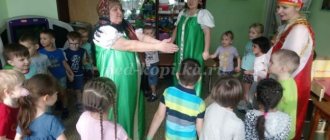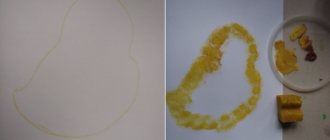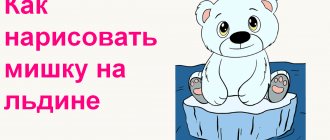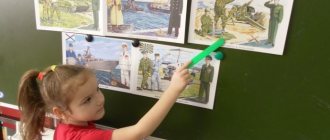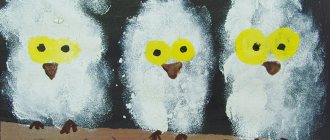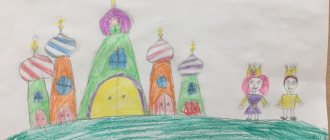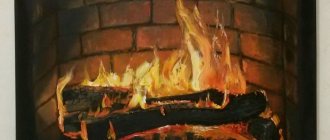GCD for drawing in the middle group Topic: “Apple-ripe, apple-sweet”
Guzel Sitdikova
GCD for drawing in the middle group Topic: “Apple-ripe, apple-sweet”
-Continue to introduce children to paint apple with gouache paints .
-Show the possibility of depicting half an apple (with colored pencils or felt-tip pens)
.
-Develop aesthetic perception, the ability to convey the characteristic features of an artistic image.
-Cultivate artistic taste.
Preliminary work: Didactic games “Fruits and vegetables”
,
“Guess the taste”
,
“Wonderful bag”
.
Reading the text by L. Tolstoy “The old man planted apple trees ”:
— The old man was planting apple trees . They said to him: “Why do you need apple trees ? fruit from these an apple from them .” The old man said: “I won’t eat it, others will eat it, they’ll thank me.”
Recommended teaching aids, clarity.
Posters "Fruit"
,
“Trees”
,
“Color.
Rainbow" .
How to draw an apple tree step by step with a pencil (for beginner artists)
Although drawing an apple tree by children can be done easily, without highlighting each leaf, you can outline the contours of the crown and paint it green, leaving circles of fruit.
It is interesting to depict an apple tree blooming in spring, but more often it can be seen in children's drawings with fruits. They can be red or yellow, as light green ones will blend in with the foliage and not be clearly visible in the picture. In this article we will tell you how to draw an apple tree step by step with a pencil. Beginning artists will find the advice collected in one material useful. It is better to work with a simple pencil, so that if the line is drawn unsuccessfully, you can correct the drawing with an eraser. Then you can color the picture with colored pencils or wax crayons, gouache paints or watercolors. The main thing is to learn to draw the contours of the trunk and crown.
Progress of the lesson
Educator: Children, I’ll tell you a riddle, and you listen carefully and tell me the answer:
It fell from a branch,
It rolled and disappeared.
- And it didn’t disappear at all!
Yanik got it!
Guess what fell?
What was rolling? What's missing?
Children: Apple (If children find it difficult to say, then the teacher helps)
Surprise moment: Children, someone is knocking on our door. (The teacher opens the door)
.
The group includes a squirrel .
Squirrel: Hello children.
Children: Hello squirrel.
Squirrel: I came to you today with gifts, laying out apples of different varieties on the table. What do you guys think, what is this?
Children: Apples .
Squirrel: That's right, these are apples .
Educator: Well done guys. And now I suggest you look at the apples that the squirrel brought us. What shape are they?
Educator: How do ripe apples
Children: When ripe they are sweet, not when ripe they are sour.
Educator: And now I suggest you draw a ripe , juicy apple with a red side.
Educator: And now I will show you the sequence of work:
The apple is ripe , red,
Apple crispy,
I'll break the apple in half
an apple with my friend.
Educator: And now I will show you an apple , and I suggest you draw a cut apple from life with colored pencils.
Look at all the drawings with the children, invite the children to clean everything on their tables. And after cleaning, the design of the exhibition of children's drawings “Ripe Apples ”
.
Squirrel: Children, let's play the game "Wonderful Bag"
. This bag contains geometric shapes, you take the object with your hands and tell me what kind of object it is, without looking into the bag.
Children and Squirrel play a didactic game. After playing, Squirrel says goodbye to the children.
Squirrel: Goodbye guys.
Application “Apple” in the first junior group Thinking about something interesting for me to do with my kids, I decided to make with them this original application called “Apple”. For this one.
Application with design elements in the junior group “Apple for little hedgehogs” Application with design elements in the junior group “Apple for little hedgehogs”. Purpose of the lesson: to play out the fairy tale situation - division.
Summary of GCD for modeling “Apple, pear, plum” in the senior group, part I. Introductory. The teacher makes riddles about fruits. 1 riddle. This fruit is round, or rather spherical. It's small at the top.
Summary of an open GCD for speech development in the preparatory group “Retelling the story by V. Sukhomlinsky “The Apple and the Dawn” GCD Development of speech and reading fiction Topic: Retelling the story of V. Sukhomlinsky “The Apple and the Dawn” Goal: To develop speech.
Summary of a lesson on speech development in the senior group “Apple. Compiling a descriptive story" Summary of a lesson on speech development in a preparatory school group Topic: "Apple. Compiling a descriptive story" Correctional and educational.
Summary of a lesson on drawing with plasticine on the topic “Apple” (preparatory group) Summary of a lesson drawing with plasticine Topic: “Apple” preparatory group The lesson of modeling, drawing from plasticine “Apple” develops. Master class “Apple” Today, in honor of the “Apple Saved” holiday, I invited the children to make apples out of colored paper. Of course, everyone agreed and we got started. My art. Knitted napkin “Apple” Today I want to tell you about my old hobby - knitting. Knitting is perhaps one of the very first handicraft arts.
GCD “Wonderful Apple” Goal: to form cognitive interest in a person; introduce the organ of vision - the eye. GCD move: Educate. : Guys, before you know it.
Autumn Festival for children of the middle group “The Last Apple” “The LAST APPLE” 2015 Teachers: Zakharova Alexandra Nikolaevna, Tarasova Olga Nikolaevna. Children run on tiptoes to the music.
Source
Abstract “The apples are ripe on the apple tree” outline of a drawing lesson (middle group)
State budgetary preschool educational institution
kindergarten No. 124 of a combined type of Nevsky district of St. Petersburg
ABSTRACT
Continuous educational activities on artistic and aesthetic development (drawing) with children 4-5 years old in a group of general developmental orientation
Topic: “The apples are ripe on the apple tree”
Educator: Vasilyeva M.Yu.
Saint Petersburg
2019
Continuous educational activities
with children of the middle group of general developmental orientation
Types of activities: gaming, productive, musical, cognitive-research, motor, communicative.
Type of lesson: integrated
Forms of educational activity: continuous educational activity.
Goal: To develop the ability to convey the shape and color of a familiar fruit in a drawing using non-traditional techniques.
Tasks:
Educational:
— Develop the ability to draw apples using the finger technique (drawing with one finger).
— To strengthen children’s skills using the dipping method to draw leaves on a tree in green and yellow, to draw apples using an unconventional drawing technique: with cotton swabs. — Activate the names of the tree (apple tree) in children’s speech. Reinforce the meaning of complex words (apple orchard).
Educational:
— Develop fine motor skills of the hands.
— Develop a sense of composition and color in the process of using various techniques to create an expressive image of apple fruits;
— Strengthen cultural, hygienic and socio-communicative skills.
— Lead children to an emotional aesthetic assessment of their works.
Educators:
-To instill in children an interest in visual arts and a love of nature.
— Develop skills to work in a team.
Preparatory work: observations on walks, looking at the apple orchard, reading stories, looking at illustrations, paintings, didactic and verbal games.
Materials and equipment.
Play equipment: apple tree, hedgehog toy.
Audio recording of the song “Harvest” lyrics. and music A. Filippenko.
Didactic material: illustrations of apple trees, gouache in red, green and yellow, cotton swabs, a wet wipe for each child, album sheets.
Educational technologies:
— technology of research activities;
-TRIZ;
— ICT technology;
- health-saving;
Integration of educational areas: artistic and aesthetic development, cognitive development, speech development, social and communicative development, physical development.
PROGRESS OF THE CLASS
I Introductory part.
Educator: Children, let's wish each other health and good mood. Come on, children, stand in a circle! I am your friend and you are my friend. Let's hold hands tightly and smile at each other. Educator: Leaf fall, leaf fall, yellow leaves are flying. When does this happen? Children: In the fall. Educator: And in the fall, people harvest in the garden. Round, ruddy, I grow on a branch. Adults and little children love me. Educator: What is this? Children: apple.
II Main part.
Educator: Today we will go to the apple orchard. - Look, what a beautiful tree with apples. Educator: Tell me, where do apples grow? Children: on the tree. Educator: Let’s remember what parts the tree consists of? Children: trunk, long and short branches grow on the trunk. Educator: Look, what color are the leaves on the tree? D. leaves are green and yellow. Educator: What color are the apples on the branches? Children: The apples are red.
Educator: What shape are apples? Children: round apples. Educator: Children, quietly I hear some rustling and sounds. They quietly sat down on the magic rug. Teacher: (says the words puff-puff-puff) Look, there is a basket, and there are leaves in it, and someone is sitting under the leaves. Teacher: (opens the foliage, and there is a hedgehog) Who is this? Children: Hedgehog. Educator: A hedgehog came to us. Is the hedgehog upset for some reason? Educator: Hedgehog, what happened to you? Hedgehog: I live in a large garden, there are a lot of apple trees, on which red apples have ripened, and now autumn has come, it’s time to harvest. People will pick all the apples, and my apple orchard will not be beautiful. And that’s why I was upset. Educator: Children, I suggest drawing apples for the Hedgehog. Physical education minute Educator: We stood near the chairs. And let's play with our fingers. There is an apple tree by the road. (arms above head) An apple hangs on a branch. (put your wrists together) Shake the branch vigorously, (arms above your head, move back and forth) Here we have an apple. (palms in front of the chest) Practical independent activity: Sit up straight. Teacher: - Today we will be wizards, we will draw not with a brush, but with a finger and cotton swabs. Teacher: Look what a beautiful tree with apples we will draw for the Hedgehog. First, we draw the leaves with cotton swabs (we put green paint on a cotton swab and use the dipping method to draw leaves on the branches) Educator: You can start working. — Tell me, what color do we take paint? (green) Educator: Now we draw yellow leaves. (we put yellow paint on a cotton swab and draw yellow leaves) Educator: Children, show how you will draw yellow leaves. Educator: We painted the leaves, and now we draw apples on the branches. (shows to the children). I take my index finger and dip it in paint (not the whole finger, but just the tip) and apply it to the branch. Educator: Children, show me your index finger. We draw carefully, put paint on your finger well so that the apples are juicy. We draw a lot of apples to make our tree beautiful. What color will we paint the apples with? Children: Red. (The teacher helps in the drawing process, monitors the children’s posture) Educator: Whoever drew apples, wipe your finger with a napkin. Educator: Take your work and hang it on our apple tree.
III Final part.
Reflection. Educator: What great fellows you are. What beautiful trees with apples we got. Remember the name of the garden where apples grow? Children: Apple orchard. Educator: Now the Hedgehog will have apples all year round. - Children, what did we draw? (apple orchard) - Who did we help? Children: (to the hedgehog) Educator: We have prepared a surprise for the Hedgehog. Children, stand around our apple tree and sing a song. We carry baskets, sing a song in chorus, collect the harvest. And stock up for the winter. Chorus: Oh, yes, collect it. And stock up for the winter.Teacher: for your beautiful drawings, I have prepared a surprise for you and the hedgehog. Look what's in the basket? Children: apples. Educator: Apples have a lot of vitamins, they are very tasty and good for your health (give the apples to the children).
Notes on drawing “Ripe, red, sweet apple” in the middle group
Elena Kolesnikova
Notes on drawing “Ripe, red, sweet apple” in the middle group
Educator: Kolesnikova E.V.
Lesson notes on art activities in the middle group .
Drawing with paints (from life)
“
The apple is ripe , red , sweet .”
Goal: to teach children to create from nature and from imagination the image of a ripe , red apple .
1. Teach children to paint a multi-colored apple with gouache paints .
2. Show the possibility of depicting half an apple .
3. Develop aesthetic perception, the ability to convey the characteristic features of an artistic image.
4. Cultivate artistic taste.
Didactic game “Wonderful bag”.
Option with carved edges
Let's look at another way to draw an apple tree step by step with a pencil. In the fall, a child at school may be given a homework assignment to draw a fruit tree with fruits. The easiest way to depict an apple tree. A school-age child will be able to cope with the task of first drawing a large circle, then filling its contours around the entire perimeter with rounded corners. These are the leaves that are visible on the sides of the crown. They can be located either in one direction or towards each other.
Preview:
Lesson notes on fine arts (in the middle group)
Teach children to depict an apple using a means of expression: color, shape, size, correct location on the sheet.
Strengthen the skills of shaping movements and moving the brush along the pile.
Education of aesthetic perception of still life.
Examination and description of various fruits.
Examination of the still life by P. P. Konchalovsky “Apples on the table”
Materials, tools, equipment:
Gouache paints, brushes, cups, napkins, cardboard plates, palettes, apples according to the number of children, a bag, a Bunny toy.
Educator: Guys, look what I found! (showing the bag)
I’ll tell you a riddle now, and the answer is in this bag.
Adults love me
Educator: Well done! You have solved the riddle. There is an apple in the bag.
Educator: Guys, do you hear someone crying!
Interesting, I'll go and have a look. (the teacher brings in the hare)
Educator: Hello bunny! Why are you crying?
Educator: Look, Bunny, is this your bag?
Bunny: Yes! Where did you find it?
Educator: We found it here in the group, but there is only one apple.
Bunny: How come, where did the rest of the apples go?
Educator: Look, Bunny! There's a big hole in your bag. While you were running, you lost almost all the apples along the way.
Educator: I think I came up with it! Now the guys and I will draw apples. Are you a bunny living in a fairy forest? And there everything drawn turns into the real thing.
Bunny: Let's dance together!
Physical school
Educator: Well done! We had a lot of fun!
Let's help the bunny draw apples?
(Children sit at tables)
Educator: We will draw our apples on a plate. These plates are not simple, they are magical, as soon as they get into the fairytale forest, the painted apples will turn into real ones. To do this, we need to try and become artists.
Children: Artists paint pictures.
Ah, now I want to introduce you to the works of real artists who painted still lifes. A still life is a painting that depicts flowers, fruits, household items, and things that a person uses. These artists also depicted apples in their paintings.
(I put the bunny on the stand) Sit down, bunny, and listen carefully.
I. Khrutsky “Flowers and Fruits”.
Educator: Look carefully at this still life.
—What do you like most?
In this picture everything looks like the real thing. Beautiful flowers, juicy apples, velvety peaches, transparent grapes.
K.S. Petrov-Vodkin “Apple and Cherry”
Educator: Oh, this is a still life by another artist.
— How does this still life differ from the previous one?
Here the artist depicted only an apple and a cherry.
Cherry answers: “Yes, I am smaller than you, but very tender, my skin is transparent and thin. I am filled with aromatic juice. And my color is much brighter than yours. I have a deep scarlet color.”
Regular apple
First, we suggest you see how to draw an apple with a pencil in one of the simplest ways. This design is quite similar to a real fruit; later you can fill it with your favorite color.
We draw a circle, since this is the shape that the depicted fruit usually has.
The place where the stalk attaches to the fruit is usually slightly concave. Let's depict it as an arc. From it upward we draw the stalk of the stalk.
Let's correct the shape of the apple from above at the stalk and below, where the flower bloomed. Let's add a leaf.
At the end, remove the extra lines with an eraser and add veins to the leaf. The drawing is ready.
Leave your comment
Responsibility for resolving any controversial issues regarding the materials themselves and their contents is taken by the users who posted the material on the site. However, the site administration is ready to provide all possible support in resolving any issues related to the work and content of the site. If you notice that materials are being used illegally on this site, please notify the site administration using the feedback form.
All materials posted on the site were created by the authors of the site or posted by users of the site and are presented on the site for informational purposes only. Copyrights for materials belong to their legal authors. Partial or complete copying of site materials without written permission from the site administration is prohibited! The opinion of the administration may not coincide with the point of view of the authors.
Source
How to draw a tree without leaves
You need to learn to draw a tree from its trunk and branches. So we will show beginners how to draw an apple tree step by step with a pencil, first without leaves and fruits. Start work from the bottom up from a flat part of the trunk. It is drawn in the usual way: from below the trunk expands slightly due to the roots, and closer to the top of the tree it narrows.
The asymmetrical branch located first looks interesting. To do this, a branch is made on one side of the smooth trunk, first a straight part of the branch, and then several small ones are drawn at its end. Next, a small segment of a straight trunk is extended, and paired branches are drawn in different directions. The branches can be placed opposite each other or with a slight upward shift. At the points of their connection with the trunk, expansion is made. The top of the tree has several small branches emanating from a single point. Each detail shows from 2 to 4 small branches.



